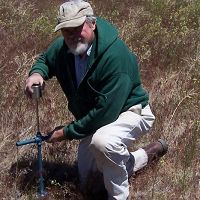McCorkle et al., 2016
Tracing the Source of Soil Organic Matter Eroded from Temperate Forest Catchments Using Carbon and Nitrogen Isotopes.
McCorkle, E.P., Berhe, A.A., Hunsaker, C.T., Johnson, D.W., McFarlane, K.J., Fogel, M.L., Hart, S.C (2016)
Geology.
-
Reynolds, Sierra, STAFF
-
Sierra, INVESTIGATOR
-
Sierra, INVESTIGATOR
-
Sierra, INVESTIGATOR
-
Sierra, COLLABORATOR
-
Sierra, INVESTIGATOR
Abstract
Soil erosion continuously redistributes soil and associated soil organic matter (SOM) on the Earth's surface, with important implications for biogeochemical cycling of essential elements and terrestrial carbon sequestration. Despite the importance of soil erosion, surprisingly few studies have evaluated the sources of eroded carbon (C). We used natural abundance levels of the stable and radioactive isotopes of C (13C and 14C) and stable isotope of nitrogen (15N) to elucidate the origins of SOM eroded from low-order catchments along the western slopes of the Sierra Nevada of California, USA. Our work was conducted in two relatively undisturbed catchments (low elevation = 1800 m, and high elevation = 2300 m) of the Kings River Experimental Watersheds (KREW) in the Sierra National Forest. Sediment captured in basins at the outlet of each gauged watershed were compared to possible source materials, which included: upland surficial organic horizons (i.e., forest floor) and mineral soils (0–0.6 m) from three landform positions (i.e., crest, backslope, and toeslope), stream bank soils (0–0.6 m), and stream-bed materials (0–0.05 m). We found that most of the organic matter (OM) in the captured sediments was composed of O-horizon material that had high C concentrations. Radiocarbon analyses also showed that the captured OM is composed of modern (post-1950) C, with fraction modern values at or above 1.0. Our results suggest that surface (sheet) erosion, as opposed to channeling through established streams and episodic mass wasting events, is likely the largest source of sediment exported out of these minimally disturbed, headwater catchments. The erosional export of sediment with a high concentration of C, especially in the form of relatively undecomposed litter from the O horizon, suggests that a large fraction of the exported C is likely to be decomposed during or after erosion; hence, it is unlikely that soil erosion acts as a significant net sink for atmospheric CO2 in these low-order, temperate forest catchments.
Citation
McCorkle, E.P., Berhe, A.A., Hunsaker, C.T., Johnson, D.W., McFarlane, K.J., Fogel, M.L., Hart, S.C (2016): Tracing the Source of Soil Organic Matter Eroded from Temperate Forest Catchments Using Carbon and Nitrogen Isotopes. Geology.. DOI: 10.1016/j.chemgeo.2016.04.025
Explore Further






